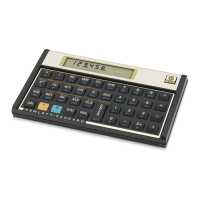110 Statistics
Example 1:
A suspect die from a Las Vegas casino is brought to an independent testing
firm to determine its bias, if any. The die is tossed 120 times and the following results
obtained.
Number 1 2 3 4 5 6
Observed Frequency 25 17 15 23 24 16
The expected frequency = 120 throws / 6 sides, or E = 20 for each number, 1 thru 6.
(Since E is a constant in this example, there is no need to store it in R
0
each time.)
12c platinum / 12C
RPN Keystrokes
12c platinum
ALG Keystrokes
Display Comments
fCLEARH fCLEARH
25\ 25-
20?0-\ 20?0³g’
§:0z+ z:0+~³
1.25
17\20- 17-20³g’
\§:0z+ z:0+~³
1.70
15\20- 15-20³g’
\§:0z+ z:0+~³
2.95
23\20- 23-20³g’
\§:0z+ z:0+~³
3.40
24\20- 24-20³g’
\§:0z+ z:0+~³
4.20
16\20- 16-20³g’
\§:0z+ z:0+~³
5.00
χ
2
The number of degrees of freedom is (n-1). Since n = 6, the degrees of freedom = 5.
Consulting statistical tables, you look up
χ
2
to a 0.05 significance level with 5 degrees of
freedom, and see that
χ
2
0.05,5
= 11.07. Since χ
2
= 5 is within 11.07, we may conclude that
to a 0.05 significance level (probability = .95), the die is fair.
Try the following HP 12C Platinum program with the same example.

